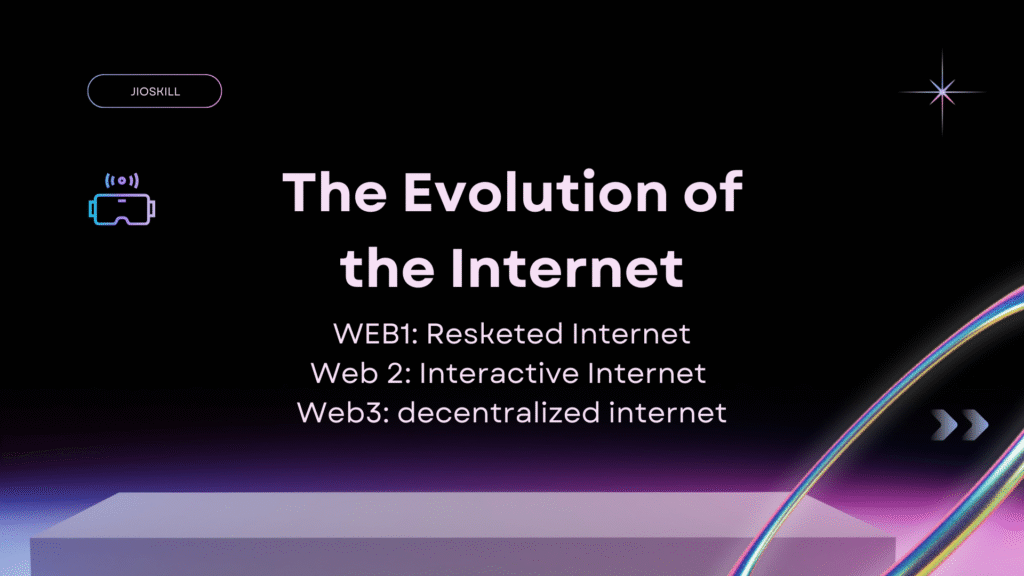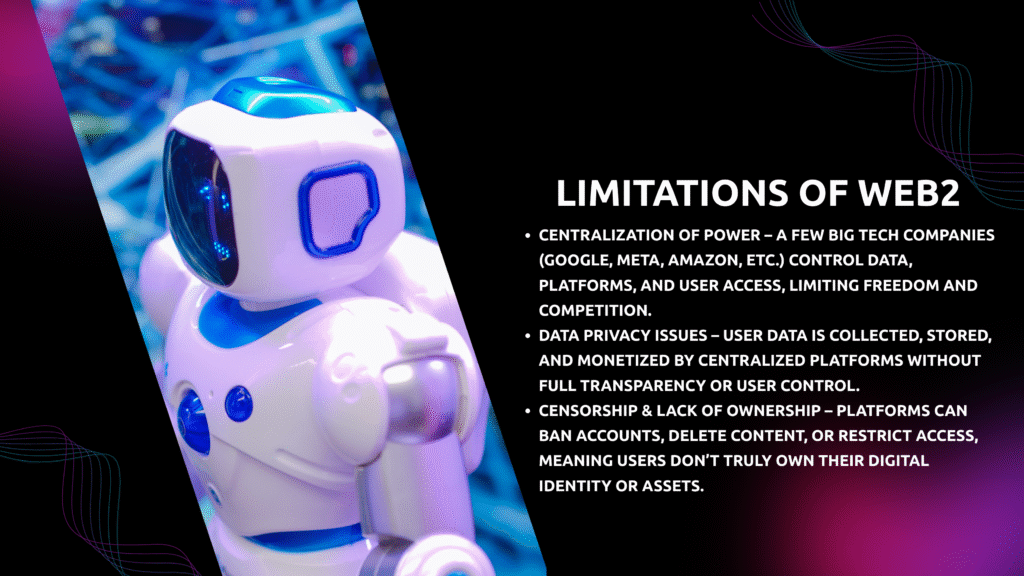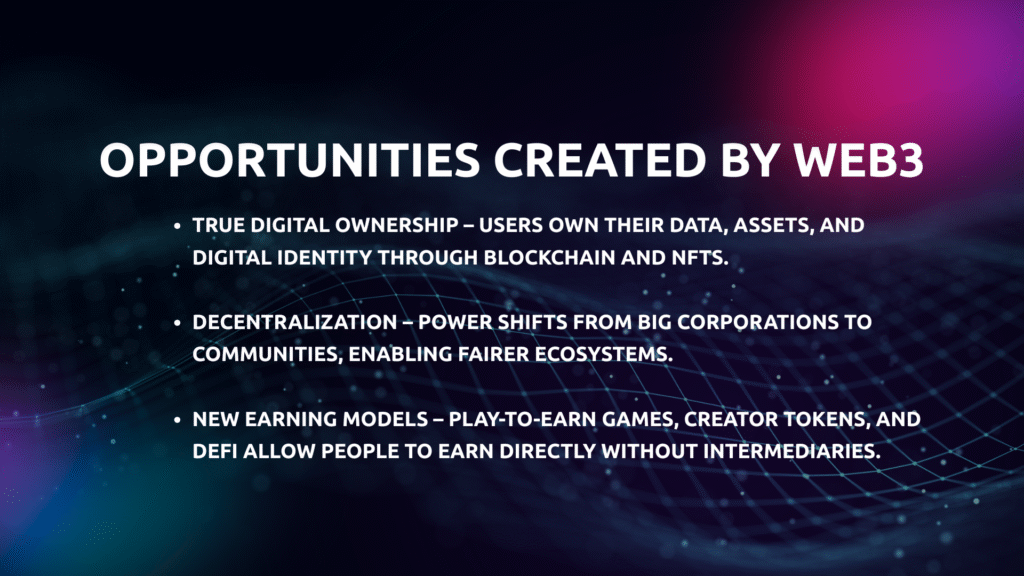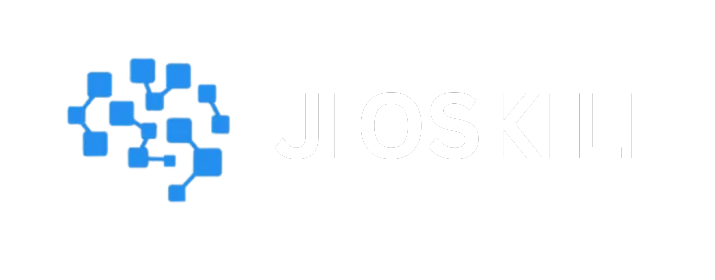Currently Empty: ₹0.00
Web3 Explained: The Future of the Internet
There have been significant changes in the Internet in recent decades. From the first days of Web1, a “read-only” Internet, Web2, Interactive, Social and User-Janite Materials time, we are now entering a decentralized, user-centric and reliable Internet.
But what exactly is web 3, and why is it considered the Internet? In this blog we will discover the boundaries of the Internet, web 2, how web 3 addresses these challenges, and what is the future. Web3 Explained
The Evolution of the Internet

WEB1: Resketed Internet
The web1 (1990s 2000s) were primarily stable. Users could only read information from websites, and the conversation was minimal. It was like reading a newspaper online, but also a way.
Web 2: Interactive Internet |
Web2 (Middle-20000 S-Presest) introduced user-related materials, social media and interactive platforms. Facebook, YouTube, Instagram and Twitter became central hubs where people could have been connected, shared and attached.
While the Web2 gave users the opportunity to create and interact, it also centralized the control of technical giants such as Google, Meta and Amazon.
Web3: decentralized internet
The aim of the web3 is to distribute control from centralized authorities to users themselves. It uses blockchain technology, cryptography and decentralized networks to create more open, transparent and user -owned internet.
In Web3, users can own their data, participate in decision -making processes and safely interact with digital assets.
The Problem: Limitations of Web2
While web 2 has changed the digital world, it comes with significant boundaries:
1-Centralized control
Most web 2 platforms are controlled by some companies. This centralization gives them the power to determine which materials are allowed, how data is used, and what services succeed or fail.
2- Data privacy and abuse
Social media platforms collect large amounts of user data, often without transparent consent. High -profile fraud such as Cambridge Analytica revealed how data can be abused for political and commercial purposes.

3- Economic exclusion
Traditional financial and online payment systems often exclude people without bank access. The transaction fee is high, and the payment from the border is slow and animals.
4-Lack of real ownership
Material creators and digital artists often lack full control of their work. Platforms such as YouTube and Spotify determine the distribution of income, leaving the creators a small stake.
Movement: Why do these problems mean something important
The results of these web 2 restrictions are marked at several levels:
- Monopoly and censorship: Centralized platforms can ban users or suppress material without openness, threaten freedom of speech.
- Incorrect income distribution: Manufacturers struggle to do the work properly and limit traditional economic systems to global users.
- Safety risk: Centralized data is an attractive measure for hackers. Fractures can compromise personal information from millions of users.
- Lack of transparency: Users rarely know how their data is used or who benefits from them Web3 Explained .
These issues highlight the urgent need for a new internet model that prioritizes user control, transparency, and decentralization.
Solution: How to address web3 web2 problems
Web3 introduces a paradigm change by giving users back to users through many core technologies:
1. Decentralization
Unlike web 2, where data and services are governed by centralized institutions, web 3 is run on a decentralized network. It reduces the risk of individual points for sensorism, fraud and failure.
2. Blockchain technology
Blockchain acts as a public account book, records all transactions transparent and irreversible. This allows reliable interactions where users do not require intermediaries to confirm tasks.
3. Smart contract
Smart contracts are self -imposed agreements encoded on blockchain. They automatically use conditions without middlemen. For example, a smart contract can automatically release payment when a service is distributed.
4. Cryptocurrency and Token
Digital currencies such as Bitcoin and Atherium allow safe colleagues to colleague transactions. Tokens can represent ownership of digital assets, provide voting rights in local communities or access to services.
5. Decentralized autonomous organizations (daos)
Daos are online organizations managed by members instead of centralized officers. Members vote on suggestions that use symbols and create a democratic and transparent governance model Web3 Explained .
6. Real World Application
- Finance (Defi): Platforms such as Uniswap, Aave and Compound allow users to lend, borrow and shop without banks.
- Games: Games like Xy Infinity and Dysentraland reward players with digital assets that they are actually their own.
- Supply series: Improves openness and traceability for blockchain products.
- Health services: Patient data can be safely stored and can only be reached with consent.
Opportunities created by web 3
Web3 is not just a technological upgrade – it opens up new opportunities for individuals, creators and businesses:
1- Economic inclusion
The DEFI platforms offer banking services to population population worldwide. Any person with internet access can participate in loans, borrowing or trade.
2- Digital ownership
NFTs (non-captive symbols) allow creators to sell digital art, music or virtual objects with evidence of ownership and royalty and are automatically used through smart contracts.
3- Openness and security
The irreversible laser of blockchain ensures confidence in transactions, control and material distribution.
4-New business model
Web3 lets creators, developers and entrepreneurs build local communities, mudge and work without middlemen.
5- Extended user experience
Users can interact with decentralized apps (dapps) without relying on the same platform, increasing freedom and control.
Web 3 Challenges
Despite the promise, web3 is facing many obstacles:
- Scalability: Blockchain networks such as atherium can be slow and expensive during top use. Solutions such as layer -2 scaling and alternative blockchain (Solan, Polygon) appear.
- Regulation: Governments still define legal framework for cryptocurrency, NFT and Daos.
- User adoption: Web3 technologies can be complex, and mainstream users may find it difficult to navigate.
- Environmental considerations: Some blockchain networks use large amounts of energy, even if evidence-of-set solutions are reduced.

Case Study: Web 3 in action
- Atherium
Ethereum enables smart contracts and dapps, which run decentralized finance, NFTs and Daos. - Solana and Polygon
These platforms provide fast and cheap transactions, enabling mass adoption for games and finance. - Play
- Exi Infinity: Players serve Cryptocurrency while playing.
- DESCTENTALAND: Virtual Real Estate is purchased, sold and developed with blockchain.
- Financing
- UNISWAP: decentralized exchange for colleagues for colleague -token trade.
- AAVE: Borrowed and borrowed platform without banks.
- Web 3 Seeking Business
Companies such as Nike, Adidas and Coca-Cola experiment with NFT, Token loyalty programs and digital collections.
Future of Web 3 (2025 and beyond)
The next step in the web3 can again define how we live, work and talk online:
Web3 + ai + metaverse
Artificial intelligence can increase dapp, personal experience and future analysis in decentralized platforms. Integration with metavense will create an engrossing, blockchain-based virtual world.
Token economies
Property, shares or even real values such as intellectual property can be token, enabling partial ownership and global trade.
Employment options
Web3 creates a new career in blockchain development, NFT construction, Defi consultation and DAO rule.
CO -existence with Web3 Web2
Instead of replacing Web2 2, web3 may be in coexistence, which still provides decentralized alternatives while interacting with centralized platforms.
Frequently asked questions (common questions)
Q1: What is web 3 with simple words?
Web3 is the next generation of the Internet where users own their data, interact directly without intermediaries and participate in a decentralized network using blockchain.
Q2: Is web 3 safe?
While blockchain technology is safe, the web 3 application can have weaknesses. Users should be careful, such as using secure wallets and verify dapp sources.
Q3: How is Web3 different from Web2?
Web2 is centralized, where data and strength are controlled by companies. Web3 is decentralized, giving users ownership, openness and control.
Q4: How can beginners start with Web3?
Start making a crypto -wall book, try the NFT search, defi platforms and learn basic blockchain. Education is important before investing the actual amount.
Conclusion
Web3 represents a transformation change of how the Internet works. By addressing the centralization of web2, the lack of privacy problems and lack of ownership, web3 users, creators and businesses to participate in a decentralized digital economy.
Despite the challenges such as scalability, regulation and adoption, opportunities offered by Web 3 – financial freedom, real digital ownership, openness and new business models – do the most exciting development of the Internet yet.
The Internet time is not just about consuming materials – it’s about the owner, controlling it and being part of a global, decentralized ecosystem.
Web3 is not a distant dream; It is already here, giving shape to the next chapter in our digital lives.
Click Here https://jioskill.com/how-ai-is-transforming-it-consulting-opportunities-challenges-and-the-future-2025/







